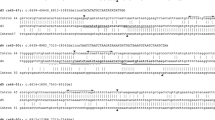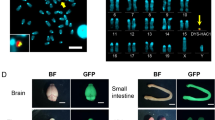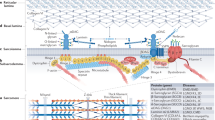Abstract
Recent progress has resulted in part of the gene mutated in Duchenne and the milder Becker muscular dystrophies being cloned1–3 and has suggested that the gene itself extends over 1,000 to 2,000 kilobases (kb) (ref. 4). To study how mutations in this gene affect muscle development and integrity, it would be of interest to have available a mouse model of the human disease. The mouse mdx mutation affects muscle and confers a mild dystrophic syndrome, but it is not clear whether this mutation is equivalent to Duchenne/Becker muscular dystrophy in man5. Here we describe the use of two sequences from the human Duchenne muscular dystrophy (DMD) gene that cross-hybridize to mouse X-linked sequences to localize the gene homologous to DMD in the mouse. Both sequences map to the region of 10 centimorgan lying between the Tabby (Ta) and Stl4-l (DxPas8) loci, close to the phosphory-lase b kinase locus (Phk). By analogy with the human X-chromosome, we conclude that the region in the mouse around the G6pd and Stl4-l loci may contain two genes corresponding to distinct human myopathies: Emery Dreifuss muscular dystrophy which is known to be closely linked to Stl4-l in man6,7 and the DMD homologue described here.
This is a preview of subscription content, access via your institution
Access options
Subscribe to this journal
Receive 51 print issues and online access
$199.00 per year
only $3.90 per issue
Buy this article
- Purchase on Springer Link
- Instant access to full article PDF
Prices may be subject to local taxes which are calculated during checkout
Similar content being viewed by others
References
1. Ray, P. N. et al. Nature 318, 672–675 (1985). 2. Monaco, A. P. et al Nature 323, 646–650 (1986). 3. Monaco, A. P. et al. Nature 316, 842–845 (1985). 4. Monaco, A. P. & Kunkel, L. M. Trends Genet. 3, 33–37 (1987). 5. Bulfield, G., Siller, W. G., Wright, P. A. L. & Moore, K. J. Proc. natn. Acad. Sci. U.S.A. 81, 1189–1192 (1984). 6. Yates, J. R. W. et al. J. med. Genet. 29, 587–590 (1986). 7. Thomas, N. S. T. et al J. med. Genet. 23, 596–598 (1986). 8. Worton, R. G., Duff, C., Sylvester, J. E., Schmickel, R. D. & Willard, H. F. Science 224, 1447–1448 (1984). 9. Avner, P. et al. Proc. natn. Acad. Sci. U.S.A. (in the press). 10. Russell, L. B. in Cytogenetics of the Mammalian X Chromosome (ed. Sandberg, A.) 205–250 (Liss, New York, 1983). 11. Amar, L. C., Arnaud, D., Cambrou, J., Guenet, J. L. & Avner, P. R. EMBO J. 4, 3695–3700 (1985). 12. Avner, P., Bucan, M., Arnaud, D., Lehrach, H. & Rapp, U. Somatic Cell molec. Genet. 13, 267–272 (1987). 13. Dautigny, A. et al. Nature 321, 867–869 (1986). 14. Avner, P., Amar, L., Arnaud, D., Hanauer, A. & Cambrou, J. Proc. natn. Acad. Sci. U.S.A. 84, 1628–1633 (1987). 15. Huijing, R, Eicher, E. M. & Coleman, D. L. Biochem. Genet. 193–196 (1973). 16. Phillips, R. J. S., Hawker, S. G. & Moseley, H. J. Genet. Res. 22, 91–99 (1973). 17. Happle, R., Phillips, R. J. S., Roessner, A. & Junemann, G. Hum. Genet. 63, 24–27 (1983). 18. Yang-Feng, T. L., de Gennaro, L. J. & Francke, U. Proc. natn. Acad. Sci. U.S.A. 83,8679–8683 (1986). 19. Eicher, E. M., Southard, J. L., Scriver, C. R. & Glorieux, F. H. Proc. natn. Acad. Sci. U.S.A. 73,4667–4671 (1976). 20. Lyon, M. F. et al. Proc. natn. Acad. Sci. U.S.A. 83, 4899–4903 (1986). 21. Read, A. P. et al. Hum. Genet. 73, 267–270 (1986). 22. Machler, M. et al. Hum. Genet. 73, 271–275 (1986). 23. Kuehn, M. R., Bradley, A., Robertson, E. J. & Evans, M. J. Nature 326, 295–298 (1987). 24. Clarke, A. et al. J. med. Genet. 23, 501–508 (1986). 25. Chapman, V. M., Murawski, M., Miller, D. & Swiatek, D. Mouse News Lett. 72,120 (1985). 26. Bulfield, G. & Isaacson, J. H. Mouse News Lett. 72, 97 (1985).
Author information
Authors and Affiliations
Rights and permissions
About this article
Cite this article
Heilig, R., Lemaire, C., Mandel, JL. et al. Localization of the region homologous to the Duchenne muscular dystrophy locus on the mouse X chromosome. Nature 328, 168–170 (1987). https://doi.org/10.1038/328168a0
Received:
Accepted:
Issue Date:
DOI: https://doi.org/10.1038/328168a0
This article is cited by
-
Temporal changes in magnetic resonance imaging in the mdx mouse
BMC Research Notes (2013)
-
Time course study of the isometric contractile properties of mdx mouse striated muscles
Journal of Muscle Research and Cell Motility (1993)
-
Mouse X Chromosome
Mammalian Genome (1992)
-
Comparative map for mice and humans
Mammalian Genome (1992)
-
Mouse X chromosome
Mammalian Genome (1991)
Comments
By submitting a comment you agree to abide by our Terms and Community Guidelines. If you find something abusive or that does not comply with our terms or guidelines please flag it as inappropriate.



